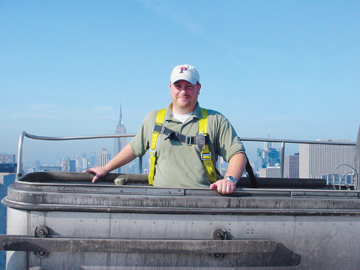When Calamity Strikes…
Engineer Nicholas Lehmann ’97 spends much of his life at disaster scenes.
Just days after the Sept. 11, 2001, attacks on the World Trade Center, Nicholas Lehmann was there to provide on-site engineering support as contractors began to move mountains of debris. Shortly after a steel cooling tower collapsed in Milford, Conn., he was on hand to figure out why it came crashing down, killing two workers. And when a parking garage wall collapsed in Philadelphia last fall, Lehmann was soon on the scene to determine what caused it to fail and how the wall should be rebuilt.
“It’s never good if we are working on your building,” quips Lehmann, 33, “because it generally means that something bad has happened.”
For Lehmann, diagnosing what causes a building to collapse or figuring out how to shore up a troubled structure lies at the heart of his engineering practice. These are the types of projects he has worked on since joining Wiss, Janney, Elstner Associates (WJE) in 1998, after graduating from Cornell University with a master’s degree in structural engineering.
Lehmann lives in Maple Shade, N.J., with his wife Erika Krick ’98, a veterinary oncologist at the University of Pennsylvania, and works from WJE’s office in Princeton, N.J. An enthusiastic weekend autocross racer, he says he enjoys the challenges his profession provides: “No two structural problems are the same. One day, I might be working on a suspended scaffold platform, investigating the travertine marble façade panels of the Solow Building in New York City; the next day, I could be looking at the condition of a concrete building after a fire, the next investigating decay in a wood building or looking at hurricane damage to a brick structure.”
After Hurricane Katrina hit New Orleans, Lehmann flew to Louisiana to analyze the storm’s destruction, representing his firm, which had contracts both with insurance companies and property owners. For the insurance companies, Lehmann was charged with determining if the damage wrought by Katrina on certain buildings was caused by wind or flooding. Many policies covered only wind damage.
For one property owner, Lehmann investigated whether the concrete foundation for a housing project had survived the onslaught. The concrete was sound, and the project moved forward.
Joseph Khan ’97, one of Lehmann’s college friends, says that Lehmann’s work is a good fit for a guy who likes to solve problems. “He’s good at figuring out who messed up to make sure it doesn’t happen again,” says Khan, an assistant U.S. attorney for the Eastern District of Pennsylvania.
Lehmann credits Swarthmore’s engineering program for providing a solid, broad-based look at the field during his undergraduate studies. He says that the program’s emphasis on lab work in each engineering course helped him develop a knack for technical writing, which is essential in his job.
“Our primary work product is a written report,” says Lehmann. “Technical writing is not something you just pick up. You have to be taught.”
Sometimes, Lehmann arrives on a job before a calamity strikes, such as last fall, when his firm was hired by a New Jersey municipality to analyze the structural condition of a 70-year-old, 110-foot–high water tower. Town officials were worried about the rust, and one engineering firm, citing the deteriorating steel and concrete foundation, had recommended tearing it down and building a new one, at the cost of more than $1 million.
Lehmann’s firm was hired to provide a second opinion. Bringing in a boom-lift, he was able to get up close to the tank so he could scrape away the rust to assess the damage. He used an ultrasonic thickness gauge to determine to what extent the steel had corroded and also analyzed the cracks in the concrete foundation.
His findings pleased the town fathers. The tower was deemed structurally sound. Lehmann recommended a few repairs and regular maintenance, thereby saving taxpayers more than $700,000. “The corrosion looked bad from the ground but was actually minimal,” Lehmann says. “And it turned out that the foundation cracks were only superficial.”
 Email This Page
Email This Page

January 19th, 2009 11:33 pm
This is a great profile! I only wish you hadn't missed the opportunity to also highlite Erika Krick, Nick Lehmann's wife, who graduated from Swarthmore in 1998 and who is also a very accomplished alum! Both Nick and Erika met while students at Swarthmore!
January 20th, 2009 2:06 am
Tell us more about Erika!
Jeff Lott, Editor